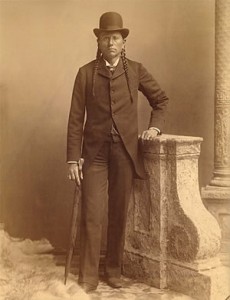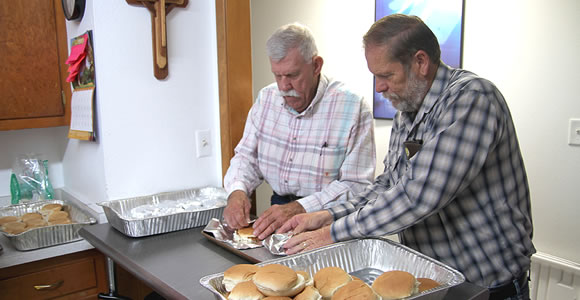
Archives for August 2014

The Love of Jesus
New to school
Hedley Fish
Christ’s Kids spreads faith through action
By Roger Estlack, Clarendon Enterprise
“Jesus loves you.” It’s a simple message, but it’s one that is best delivered with actions rather than words.
Christ’s Kids Ministry brings that message to dozens of children weekly, and over the summer months it fed those kids’ bodies as well as their souls, delivering 135 sack lunches five days a week… an estimated 7,500 meals since May.
“We just want to be a blessing and show kids that Jesus loves them,” says Steve Carter, who heads up the ministry with his wife, Janet.
As they deliver meals across Clarendon and in Lelia Lake without regard to any income guidelines, Steve, Janet, and their helpers repeat that simple message, “Jesus loves you,” and now kids come running to their delivery vans and give them the message first.
Some kids are economically disadvantaged. Some are home alone during the day. Christ’s Kids doesn’t look at those circumstances. All that matters is that a kid needs food, and the mission is to serve.
Every meal includes fruit, a drink, a cookie, and something hot such as a burger or corn dog. The Carters say they see God working every day in the ministry, whether it’s in the form of donations from across the community or in always having the right amount of food to go around. Some days there is food left over, other days supply equals demand, and then other days are more special.
“We’ve had days when we packed exactly 135 meals but had 140 kids to serve… and the meals are there,” Janet Carter said. “It’s a God thing.”
They also see the devotion of the local community, which has come through with all the money over the years to the extent that Christ’s Kids has never sought state or federal assistance.
At the start of each summer, the ministry puts a notice in the paper and sends information home with students in the school. The sack lunch program is open to kids 15 years old and younger.
“We kind of figure at 16 you’re old enough to get some kind of job, and we also just have to have a cutoff point somewhere,” Carter said.
The ministry buys much of its food from the High Plains Food Bank and also has a food pantry to help people when needed.
The ministry itself began as “Ted’s Kids” 14 years ago by Ted Shaller and David Dickinson and became known as Christ’s Kids nine years ago. The summer lunch program began five years ago.
The ministry was housed in three different churches and for a time in the Clarendon Lions Hall before the former Panhandle Community Services building became available on Kearney Street. Then about a year ago, the PCS building came up for sale.
“The PCS board offered it to us, but we said there was no way we could afford it, and they told us to just make an offer,” Steve Carter recalls. “We prayed about it and came up with the figure of $3 per square foot as all we could come up with. We offered $15,000, and they took it.”
Christ’s Kids ministers to about 40 kids on Wednesdays and Sundays, and owning their building has allowed them to make the facility available to any Christian-based group.
Carter started with Christ’s Kids nine years ago. In July, he retired from his job and now leads the ministry full time, which has allowed its mission to be expanded to include an adult Bible study to reach the kids’ parents.
The summer sack lunch program wrapped up last Friday with kids going back to school this week. Now Christ’s Kids shifts gears and works with the Snack Pack 4 Kids program to send extra food home with students that are identified by the school.
Support for the program cuts across all denominations, and the ministry has ten regular adult volunteers and is often joined by others seeking to serve, including missionaries from the Church of Jesus Christ of Latter Day Saints.
Carter doesn’t see the need for the mission diminishing and says it’s hard to stop something once it’s started.
“We’re there every day,” he said. “There are a lot of hurting people. The Lord led us to kids a long time ago, and we’ll do it as long as we can.”
Museum hosts Quanah Parker photo exhibit
The Saints’ Roost Museum invites the public to view “The Cynthia Ann & Quanah Parker Exhibit: A Woman of Two Worlds and A Man in Two Worlds,” a traveling exhibit of rarely seen photos.
The photo exhibit, on loan from the Texas Lakes Trail Region, will be on display through September at the Museum, which is open Tuesday-Saturday from 10 a.m. to 5 p.m.

Much can be learned from the dramatic story of these two courageous individuals. In 1836, a Comanche raiding party took Cynthia Ann from her family. Over the following years, she became a wife to a Comanche chief and mother to their children, including Quanah. After Cynthia Ann was taken back by Texas Rangers, Quanah became one of the most important Comanche leaders both in war and peace.
The photo exhibit tells this story of the lives of these two persons caught between two different worlds. The Lakes Trail Region views this traveling exhibit as a way to educate visitors about their lives.
The presentation of the Cynthia Ann and Quanah Parker photo exhibit at the Saints’ Roost Museum was made possible in part with a grant from Humanities Texas, the state affiliate of the National Endowment for the Humanities.
Smith gets ten years for attack
An Amarillo man was sentenced to ten years in prison last Thursday, August 21, for his role in attacking a local woman last year.
Tyler Lee Smith entered a plea of guilty when the 100th Judicial District Court met in Childress. He was convicted for the second degree felony offense of aggravated assault with a deadly weapon and was sentenced to 10 years in the Institutional Division of the Texas Department of Criminal Justice.
“This defendant used a knife during an attack on his own girlfriend causing her serious injuries which almost took her life,” said District Attorney Luke Inman. “Due to the use of the knife in this offense, he will have to complete at least five years of his sentence before becoming parole eligible.”
The crime occurred in the early hours of November 3, 2013, when 17-year-old Shantel Harris was severely beaten and stabbed in the neck in Clarendon’s North Ward park while walking home from a birthday party. She later identified her attackers as Smith and Devonte Hardaway of Clarendon.
“Domestic violence, like this case, is taken seriously by law enforcement in the 100th Judicial District and this office,” said Inman. “We recently hosted a domestic violence seminar for law enforcement in Wellington that emphasized going forward with domestic assault cases, even when you don’t have the support of the victim like we lacked in this case.”
Smith, age 20 of Amarillo, was indicted by a Donley County Grand Jury on May 14, 2014. The trial had been scheduled for August 26 in Donley County.
Inman prosecuted the case for the State of Texas with the Honorable Judge Stuart Messer presiding.
Pursuant to the plea Smith is required to pay $398 in court costs and a $2,000 fine.
Hardaway accepted a plea agreement earlier this year.
Water plan public comment period closing September 1
Interested parties have until September 1, 2014, to submit comments on the proposed rules for state water plan funding through the State Water Implementation Fund for Texas (SWIFT) and State Water Implementation Revenue Fund for Texas (SWIRFT).
Stakeholders interested in providing input on the draft rules can send written comments to rulescomments@twdb.texas.gov; to our General Counsel at P.O. Box 13231, Austin, TX 78711-3231; or through the online comment form at http://www.twdb.state.tx.us/.
The proposed rules are also available online.
The comment period opened July 11, 2014, when the draft rules were published in the Texas Register. Since then, the Texas Water Development Board (TWDB) has held three work sessions in San Antonio, San Angelo, and Fort Worth. The work sessions provided opportunities for the public to hear updates on the rule-making process and to comment before the Board. The TWDB encourages the public to continue participating in the rule development process by submitting comments before the September 1, 2014, deadline. The final version of the rules is scheduled to be published in December 2014.
Editorial: Reporters protect our freedoms
It isn’t easy being free. Threats come from all around you. Sometimes it’s from those close to home; other times it comes from far away.
Being a journalist is particularly treacherous, especially in some parts of the world. Last week, a group of barbarians literally removed the head of one American reporter. The Islamic State – described by the president earlier this year as a “JV” terrorist team – is now proving itself to be the crazy of the crazies.

But you don’t have to travel to the far side of the globe to find crazies or to find people who don’t like to have reporters poking around. In recent weeks, we’ve seen evidence of this in the “Show Me State,” where police have been arresting reporters after a big brouhaha blew up when an officer shot and killed a man.
Was that shooting justified? That’s a topic for another column. What’s important for this discussion is that the death of a minority by a white officer brought the predictable rioting and lawlessness and the equally foreseeable over-reaction by the crisis-lovers in the White House. Ergo, the St. Louis community of Ferguson hit the national spotlight and reporters flooded in.
As of last Tuesday, a total of 11 journalists had been arrested in Ferguson.
It’s worth pausing here to say that the media usually tries to work with local authorities. Each group has a job to do, and the best journalists try not to do anything that would hinder police or other first responders. Our own paper has had a great working relationship with the sheriff’s office as well as fire and EMS personnel. In my 19 years of experience, we’ve only had two occasions where someone tried to interfere with our coverage. One was a wet-behind-the-ears deputy who didn’t last long, and the other was a volunteer who thought he had more authority than he did. In both cases, the press was still given access by higher ranking authorities.
But back to Ferguson. There the police are already under scrutiny because of the nature of the events, and arresting reporters didn’t help their image any. It’s bad enough that the local police are dressed up like paramilitary troopers (in camouflage no less!) so that the whole thing looks like a scene from “Escape from New York.” But coming down on two journalists working on their stories inside McDonald’s is really over the top.
It didn’t help that that a Missouri Highway Patrol representative told reporters that, unless they were carrying $50,000 cameras, “we may take some of you into custody.” Of course, he also said they would quickly “take the proper action” – presumably let them go – once they find out who the journalists are. The catch-and-release policy is probably of little comfort to The Washington Post reporter who says police slammed him into the McDonald’s soda fountain before arresting him without a charge.
To make the bizarre situation even stranger, President Obama took to his teleprompter to defend the “criminal” journalists in Missouri.
“Here in the United States of America, police should not be bullying or arresting journalists who are just trying to do their jobs,” B.O. said.
That’s a laughable comment, coming from the man whose administration has made it a habit of bullying, wiretapping, and intimidating journalists. I guess it’s okay for him to do it but not okay for some “Whitey” cop in Missouri to do it.
Here’s something for the Hypocrite-In-Chief to mull over. Under President Obama, the United States of America has dropped from 32nd to 46th in the 2014 World Press Freedom Index, which is compiled by the press advocacy group Reporters Without Borders. The index looks at 180 countries on criteria such as official abuse, media independence and infrastructure to determine how free journalists are to report.
One German journalist had this to say about his treatment in Missouri: “I was in the civil war regions in Georgia, the Gaza strip, illegally visited the Kaliningrad region when travel to the Soviet Union was still strictly prohibited for westerners, I’ve been in Iraq, Vietnam and in China, I’ve met Cuba dissidents. But to be arrested and yelled at and be rudely treated by police? For that I had to travel to Ferguson and St. Louis in the United States of America.”
Beheadings and arrests are the extreme examples of hostile treatment of the press, but they show what can happen if we are not ever vigilant to protect our freedom. And trust me friends, if we don’t have a free press, we don’t have freedom. Who else is going to tell you what’s going on in Missouri or Syria? Who will stand up to report the abuses of government, whether in Congress, the NSA, or the city council?
“The media” is often trashed in the arena of public opinion. And people certainly have a right to their own beliefs and opinions. Reporting the news and printing commentaries on our life and times often results in someone getting their feelings hurt. Sometimes they get so bent out of shape that they let their emotions get the better of them, and they hurl insults or call for boycotts.
That’s fine. It’s their prerogative. But it is “the media” that will stand by their right to say those things even when they themselves would not extend it to others.





Reader Comments